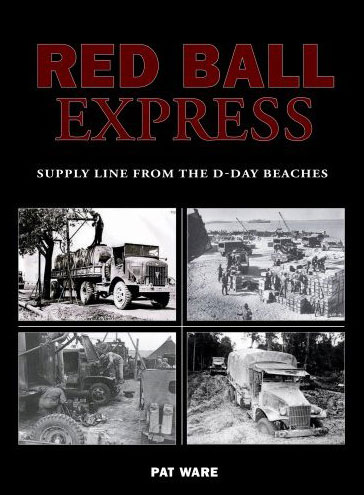|
|
|
|
Red Ball Express
Supply Line From The D-Day Beaches
by Pat Ware

Reviewed by Luke Pitt
Summary
|
Stock Number and Description |
Red
Ball Express - Supply Line From The D-Day Beaches |
|
ISBN: |
978-0-7110-3192-0 |
|
Media and Contents: |
Hard Back Book |
|
Price: |
|
|
Review Type: |
First Read |
|
Advantages: |
Interesting subject |
|
Disadvantages: |
None |
|
Recommendation: |
Highly recommended |
FirstRead
The Red Ball express was one of nine major trucking operations that
was a crucial, but unheralded part of the massive drive of allied
arms, men and machines that, by its shear weight of numbers
overwhelmed the German army during World War 2. Following the
successful landings in Normandy, the Allies had planned that the
advancing forces would be kept supplied by both rail and road with
an over land pipeline carrying fuel. For a number of reasons one of
which was the total destruction of the French rail network, this
proved impossible.
The book presented for review is hard backed with one hundred and
ninety-two pages on high quality art paper. It has six chapters with
one hundred and fifty-six colour and black and white photos. Almost
all of the colour photos are from re-inactments, while the black and
white photos are all original war-time shots. The book covers all of
the nine trucking operations carried out during the course of the
war. The photos were of great interest to me, as they covered most
of the major trucks used in the campaign. On page ninety-three, for
example, is a particularly good variation of the G.M.C. ‘Jimmy’
truck with a metal beam magnet attached to the front bumper to clear
of all things discarded ration cans that became a hazard along the
various routes. This would make a wonderful conversion for the
Tamiya G.M.C. ‘Jimmy’ in either 48th or 35th scale.
The book also covers why the majority of drivers were of
African-American descent and it is quite enlightening to why they
were chosen and how little training they were given. Chapter five
gives an excellent run down of all the trucks used in the campaign,
and to be perfectly honest, was of great interest to me as I have
never seen so many photographs in one place of all of the variations
of the trucks used in this campaign. I would definitely recommend
this book to anyone with even the remotest interest in Allied trucks
of the Second World War as it has fantastic photo coverage and is
backed up by a very readable text.
Highly Recommended.
Thanks to DLS Books for the review sample
Text and Images by Luke Pitt
Page Created 02 December, 2007
Page Last Updated
02 December, 2007
